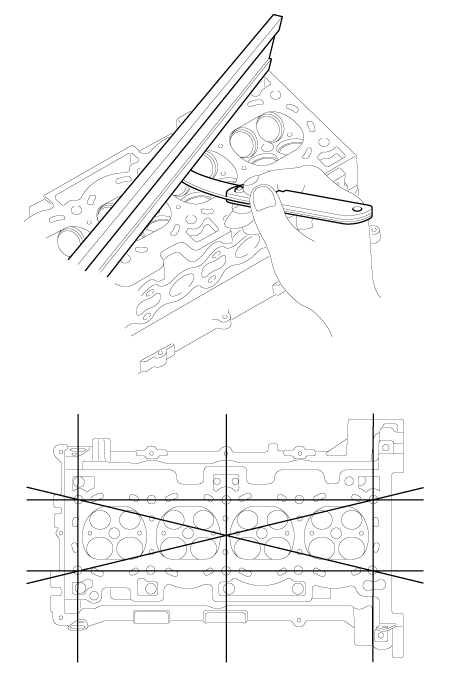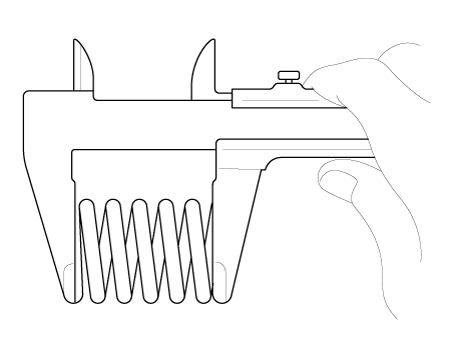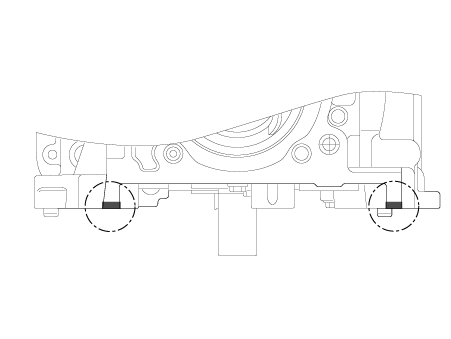Kia Sportage: Cylinder Head Assembly / Cylinder Head Repair procedures
Kia Sportage QL (2015-2025) Service Manual / Engine Mechanical System / Cylinder Head Assembly / Cylinder Head Repair procedures
| Removal |
In case of removing the high pressure fuel pump, high pressure fuel
pipe, delivery pipe, and injector, there may be injury caused by leakage
of the high pressure fuel. So don’t do any repair work right after engine
stops.
|
|
Mark all wiring and hoses to avoid misconnection.
|
| 1. |
Remove the Battery tray. -
(Refer to Engine Electrical System - “Battery”)
|
| 2. |
Remove the air cleaner assembly.
(Refer to Intake and Exhaust System - “Air Cleaner”)
|
| 3. |
Remove the engine room under cover.
(Refer to Engine and Transaxle Assembly - “Engine Room Under Cover”)
|
| 4. |
Drain the engine coolant.
(Refer to Cooling System - "Coolant")
|
| 5. |
Remove the cylinder head cover.
(Refer to Cylinder Head Assembly - "Cylinder Head Cover")
|
| 6. |
Remove the timing chain.
(Refer to Timing System - “Timing Chain”)
|
| 7. |
Remove the intake manifold.
(Refer to Intake and Exhaust System - "Intake Manifold")
|
| 8. |
Remove the exhaust manifold.
(Refer to Intake and Exhaust System - "Exhaust Manifold")
|
| 9. |
Remove the water temperature control assembly.
(Refer to Cooling System - "Water Temperature Control Assembly")
|
| 10. |
Remove the high pressure fuel pump bracket.
(Refer to Engine Control/Fuel System - "High Pressure Fuel Pump")
|
| 11. |
Remove the delivery pipe.
(Refer to Engine Control / Fuel System - "Delivery Pipe")
|
| 12. |
Remove the camshaft.
(Refer to Cylinder Head Assembly - "Camshaft" )
|
| 13. |
Remove the exhaust oil control valve (OCV) (A) using a torx wrench.
|
| 14. |
Remove the intake camshaft position sensor (CMPS) (A).
|
| 15. |
Remove the exhaust camshaft position sensor (CMPS) (A) after removing
the engine hanger (B).
|
| 16. |
Remove the cylinder head.
|
| Disassembly |
Identify mechanical lash adjuster (MLA), valves, valve springs as they
are removed so that each item can be reinstalled in its original position.
|
| 1. |
Remove the MLAs (A).
|
| 2. |
Remove the valves.
|
| Inspection |
Cylinder Head
| 1. |
Inspect for flatness.
Using a precision straight edge and feeler gauge, measure the surface
the contacting the cylinder block and the manifolds for warpage.
If the flatness is greater than maximum, replace the cylinder head.
|
| 2. |
Inspect for cracks.
Check the combustion chamber, intake ports, exhaust ports and cylinder
block surface for cracks. If cracked, replace the cylinder head.
|
Valve And Valve Spring
| 1. |
Inspect valve stems and valve guides.
|
| 2. |
Inspect the valves.
|
| 3. |
Inspect the valve seats
|
| 4. |
Inspect the valve springs.
|
MLA (Mechanical Lash Adjuster)
| 1. |
Inspect the MLA.
Using a micrometer, measure the MLA outside diameter.
|
| 2. |
Using a caliper gauge, measure MLA tappet bore inner diameter of cylinder
head.
|
| 3. |
Subtract MLA outside diameter measurement from tappet bore inside diameter
measurement.
|
| Reassembly |
Thoroughly clean all parts to be assembled.
Before installing the parts, apply fresh engine oil to all sliding and
rotating surfaces.
Replace oil seals with new ones.
|
| 1. |
Install valves.
|
| 2. |
Install the MLAs after applying engine oil.
Check that the MLA rotates smoothly by hand.
|
| Installation |
|
| 1. |
Install the cylinder head gasket.
|
| 2. |
Place the cylinder head (A) carefully in order not to damage the gasket
with the bottom part of the end.
|
| 3. |
Install cylinder head bolts.
|
| 4. |
Install the order parts in the reverse order of removal.
|
 CVVT & Camshaft Description and operation
CVVT & Camshaft Description and operation
Description
Electric E-CVVT system is electric continuous variable valve timing system.
It is located on the intake camshaft of the engine and uses motor rotation to
control the ...
Other information:
Kia Sportage QL (2015-2025) Service Manual: Power Seat Control Switch Schematic diagrams
Circuit Diagram [Driver power seat switch] [Assist power seat switch] ...
Kia Sportage QL (2015-2025) Service Manual: Rear Door Trim Components and components location
Component Location 1. Rear door trim ...
Copyright © www.ksportagegl.com 2015-2025






















